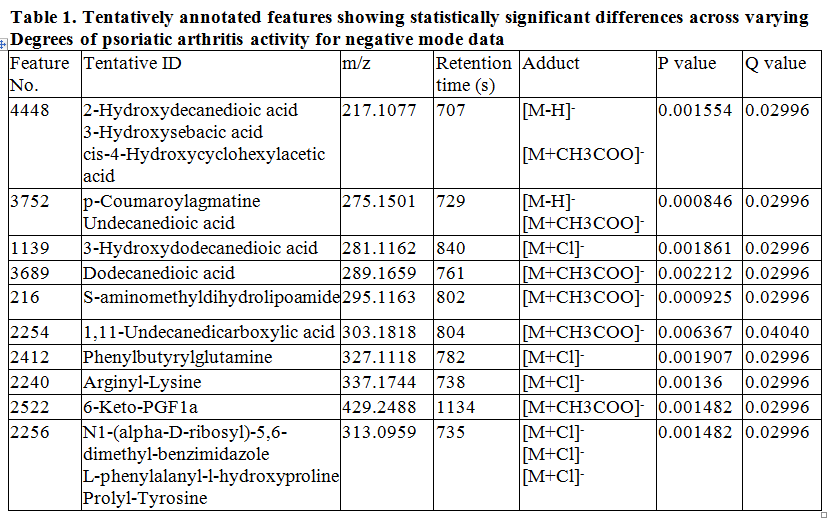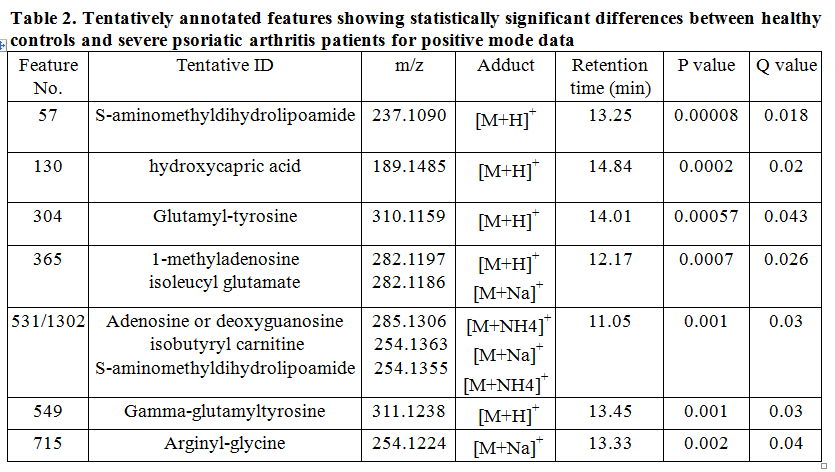Session Information
Session Type: Poster Session (Tuesday)
Session Time: 9:00AM-11:00AM
Background/Purpose: Disease activity in psoriatic arthritis (PsA) is often difficult to assess but drives treatment decisions, joint damage and long-term outcomes. We aimed to identify serum markers for PsA disease activity using metabolomics.
Methods: Serum samples were obtained from a cohort of carefully phenotyped patients with PsA satisfying CASPAR criteria (n=30, 15 males, mean age 48 years, disease duration 11 years) and healthy controls (n=10, mean age 43 years). Based on the number of actively inflamed (swollen or tender joints) patients were grouped as mild (< 4 actively inflamed and 0 swollen joints; n = 10), moderate (4-5 actively inflamed and < 3 swollen joints; n = 10) and severe ( >5 actively inflamed and >3 swollen joints; n = 10). Serum samples were processed using thin film microextraction using an established protocol. For metabolite identification high performance liquid chromatography with high-resolution mass spectrometric detection was performed using a ThermoScientific Q-Exactive mass spectrometer. MS/MS validation was performed via parallel reaction monitoring. The MS/MS spectrum obtained was compared to the fragmentation patterns of metabolites in the m/z cloud of MS finder databases. Human metabolome database was used for annotation of extracted peak using XCMS online and METLIN. Statistical analysis was performed using Metaboanalyst 4.0. For univariate analysis, a Kruskal Wallis with a false discovery rate (FDR) adjusted p-value of 0.05 was applied. For multivariate analysis, Principal Component Analysis (PCA), Partial Least Square – Discriminant Analysis (PLS-DA) and Orthogonal Projection to Latent Structures – Discriminant Analysis (OPLS-DA) were performed.
Results: PCA (figure 1a) revealed clear distinction between mild, moderate and severe PsA, but no difference between healthy controls and mild PsA. OPLS-DA (figure 1b) demonstrated a cross-validated significant separation between mild and severe PsA. Multivariate and univariate analysis yielded 10 statistically significant features across the three PsA groups, tentatively identified using xMSAnnotator for negative mode data (Table 1) while 7 statistically significant features were found to differentiate controls from patients with severe PsA and were tentatively identified using XCMS online for positive mode data (Table 2). Some of these tentatively identified compounds were found to be associated with the serine and threonine metabolism pathways and most if not all compounds presented a relative increase in concentration proportional to disease severity.
Conclusion: Untargeted metabolomics of serum via solid phase microextraction has the potential to identify markers for PsA disease activity.
To cite this abstract in AMA style:
Chandran V, Looby N, Reyes-Garces N, Machhar R, Yu M, Roszkowska A, Pawliszyn J, Kulasingam V. Serum Metabolomic Analysis of Psoriatic Arthritis Using Solid Phase Microextraction – Liquid Chromatography – High-Resolution Mass Spectrometry Identifies Putative Disease Activity Markers [abstract]. Arthritis Rheumatol. 2019; 71 (suppl 10). https://acrabstracts.org/abstract/serum-metabolomic-analysis-of-psoriatic-arthritis-using-solid-phase-microextraction-liquid-chromatography-high-resolution-mass-spectrometry-identifies-putative-disease-activity-mar/. Accessed .« Back to 2019 ACR/ARP Annual Meeting
ACR Meeting Abstracts - https://acrabstracts.org/abstract/serum-metabolomic-analysis-of-psoriatic-arthritis-using-solid-phase-microextraction-liquid-chromatography-high-resolution-mass-spectrometry-identifies-putative-disease-activity-mar/



